Proportioning the Compressed Air Dryer
Trying to figure out which air dryer capacity is best for you? Here are some factors to consider. Read More…

Dryers remove moisture and humidity from compressed air. This makes them a crucial component of your air system. That's because air is completely saturated as it leaves your compressor. This moisture can cause contamination and corrosion that can affect your entire air system, your pneumatic tools and even your final products. Using compressed air dryers is imperative, especially in industries with stringent air quality requirements. Think food/beverage, electronics, manufacturing and automotive spray-painting. But how do you know which type of compressed air dryer you need? A few basic considerations will ensure you make the right decision…
Air dryers are sized based on your ambient temperature and incoming air, as well as the capacity of your air compressor. The larger the power consumption of your compressor, the larger the flow the dryer must be able to handle. Most importantly, you want to choose the right dryer based on the temperature of your environment and the air quality needs of your application.
Some industries must adhere to stringent compressed air quality standards. They require air with a specific dew point. This is the temperature at which water vapor begins to condense into water. These high-quality air applications need the dew point of their compressed air to be low and - very importantly - to be stable. However, only those who use compressed air in these critical applications should use dew point. Companies that just want to prevent condensation of water in their pipelines and tools are well served with the term relative humidity. Since the ambient temperature over the year fluctuates, a constant relative humidity results in a fluctuating dew point. That would not be acceptable for critical applications, but it works just fine for those who only need condensation prevention. Either the risky conditions occur in the winter, which means that a higher PDP is okay in the summer. Or, if the sensitive time is in the summer, then a negative PDP is required in the winter. Note again that this only applies to condensation prevention.
Refrigeration dryers are your ideal solution if you meet the following criteria:
Refrigeration dryers use the same working principle as air conditioning units, cooling the air with a heat exchanger, a refrigerant circuit and a compressor. They come in both cycling and non-cycling variants to fit the need of your applications and operational preferences. Refrigeration dryers are very energy efficient, making them the most common dryer type.
Refrigeration dryers are often used in manufacturing plants, auto shops, food manufacturing, and breweries.
If your ambient temperature and incoming air are over 40°C/104°F, typically a high-temp dryer is recommended. Installing an after cooler after the compressor is also advised.
If you need very dry air (PDP of -40°C/-40°F or -70°C/-94°F) an adsorption dryer is your best choice. Adsorption dryers can reach pressure dew points as low as -70°C/-94°F.
That makes adsorption dryers the ideal solution for very cold climates, as they can help avoid ice formation in pipes and applications. They are also widely used in applications such as mold prevention, medical applications, textiles, and food factories.
These dryers use desiccant material to adsorb and remove the humidity from compressed air. Adsorption dryers consist of two towers. While one tower is drying air, the other is removing the moisture from already saturated desiccant. This so-called regeneration process prepares the desiccant for a new drying cycle.
Adsorption dryers also come in different technologies such as heatless dryers, heated purge dryers or blower purge and zero purge dryers.
Compressed air dryers are recommended for almost all applications. Determining the right dryer for your business is important to keep your production running as safely, reliably and efficiently as possible. As the air treatment and gas generation expert, Ash Air is here to help. Our representatives are always happy to answer your general air quality and specific dryer questions. They can also help you select the compressed air dryer that best meets your needs.
Ash Air has been around in New Zealand since 1979, and we’ve grown into a nationwide company with international support and a
reputation for quality and reliability.We look after all things compressed air for your business!
Ash Air's range of Chicago Pneumatic, Alup, Pneumatech, and Quincy compressors are used extensively around the world in industries
ranging from oil and gas to food, automotive and farming, and we bring you these world class compressors here in the land of the long white
cloud.Our technicians are compressed air equipment experts and are dedicated to addressing customer needs. Supported by a 13 locations
nationwide, Ash Air offers one of the widest selections of compressed air equipment and parts available today in New Zealand.
With Ash Air compressors, you can count on reliability and high performance for even the most demanding applications. We focus our
efforts on the following:
Talk to the team today:
Proportioning the Compressed Air Dryer
Trying to figure out which air dryer capacity is best for you? Here are some factors to consider.
Read More…
Maintenance budget: 8 factors to consider
Just like any other equipment, a compressed air installation also requires the necessary maintenance work during its entire
lifespan. Even though maintenance costs are only about 5 to 10% of a machine's annual operating costs, failure to budget for
maintenance can have potentially disastrous consequences.
Read More…
The air dyer is one of the most ignored cooler in the system. A dirty condenser will cause water in the lines, or worse it will cause
complete dryer failure.
Read More…
Do you have an idea for our #expertcorner? Let
us know!
Useful links:
Book Your Compressor Service
Who we are and how Ash Air can help your business!
Reliability and Efficiency
Read more from our #expertcorner